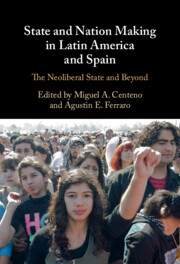Book contents
- State and Nation Making in Latin America and Spain
- State and Nation Making in Latin America and Spain
- Copyright page
- Dedication
- Contents
- Notes on Contributors
- Preface
- Part I Introduction
- Part II Economic and Territorial Power
- Part III Infrastructural Power: Reform Strategies
- Part IV Symbolic Power: Identities and Social Protest
- 11 Women Are the Social Face of the State
- 12 Europeanization Effects
- 13 Redefining Labor Organizing
- 14 Locating Neoliberalism in Abiayala
- 15 Resisting Neoliberalism? Territorial Autonomy Movements in the Iberian World
- Part V Conclusions
- Index
- References
11 - Women Are the Social Face of the State
Gender and the Social Uprising in Neoliberal Chile, 2019–2021
from Part IV - Symbolic Power: Identities and Social Protest
Published online by Cambridge University Press: 03 August 2023
- State and Nation Making in Latin America and Spain
- State and Nation Making in Latin America and Spain
- Copyright page
- Dedication
- Contents
- Notes on Contributors
- Preface
- Part I Introduction
- Part II Economic and Territorial Power
- Part III Infrastructural Power: Reform Strategies
- Part IV Symbolic Power: Identities and Social Protest
- 11 Women Are the Social Face of the State
- 12 Europeanization Effects
- 13 Redefining Labor Organizing
- 14 Locating Neoliberalism in Abiayala
- 15 Resisting Neoliberalism? Territorial Autonomy Movements in the Iberian World
- Part V Conclusions
- Index
- References
Summary
This chapter argues that successive institutional modernizations since 1990 in Chile have reconfigured the neoliberal state into an “enabling” form that preserved and entrenched the centrality and fundamental role of the market and the decentralization of social responsibility to the municipal level. The municipalization of primary health care, education, and social assistance embedded by the architects of the “subsidiary” neoliberal state, and defended in terms of greater efficiency in the delivery and quality of those public goods, was legitimized in moral-political terms. The institutional modernizations of the past three decades have been legitimated as “enabling” subjects, as gender-neutral citizens, to bear responsibility for their own well-being. They aim to resolve the fundamental contradiction between, on the one hand, the needs of a rapidly globalizing and diversifying the resource-based capitalist economy, and, on the other hand, the social reproductive activities on which that economy necessarily relies. A gendered approach reveals that women play a fundamental role in materializing the moral vision of this embodied, gendered, “enabling” state form. It shows that while women’s work provides the major share of private and social provisioning, their efforts remain largely invisible and undervalued.
- Type
- Chapter
- Information
- State and Nation Making in Latin America and SpainThe Neoliberal State and Beyond, pp. 343 - 381Publisher: Cambridge University PressPrint publication year: 2023



